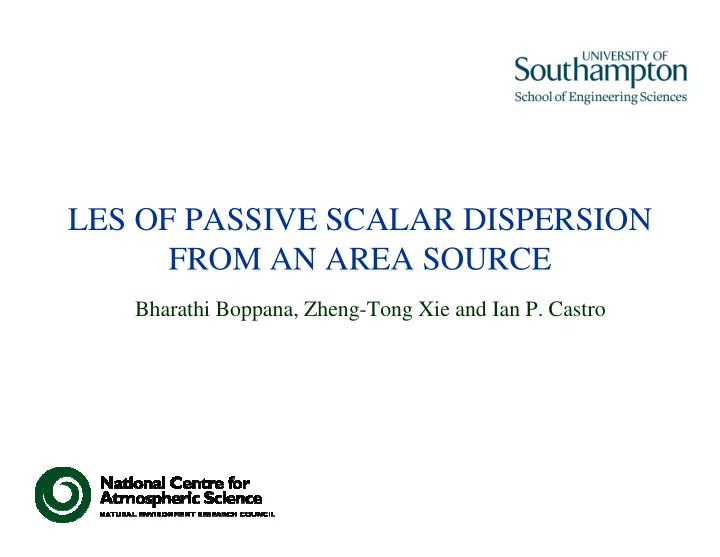

LES OF PASSIVE SCALAR DISPERSION FROM AN AREA SOURCE Bharathi Boppana, Zheng-Tong Xie and Ian P. Castro
Introduction • Surface heat flux : 1. Numerical Weather Prediction models. 2. Air quality modelling. 3. Improve the urban planning and design for human comfort. • Field measurements ( Louka et al . 1999,…, Offerle et al . 2007 ). • Wind-tunnel experiments ( Kovar-Panskus et al. 1999,….) • Many 2D CFD studies ( Ca et al . 1995,….,Cai et al. 2008 ). • Very few 3D computations ( Mathey et al. 1999,…,Yang & Shao 2008 ).
Objectives • To resolve the thin thermal boundary layer. • To estimate the surface heat flux accurately. • To understand the heat affects on flow and dispersion.
Test case Pascheke et al ., Boundary–Layer Meteorol , 2008 Uniform height staggered cubes (C10S) Non-uniform height staggered cuboids (RM10S) Focus: 1. Effect of surface roughness type on canopy ventilation. 2. Horizontal advection and vertical dispersion of the scalar through the urban canopy.
Settings C10S Flow • � p = � f = 25 % • Mean height =10 mm • Re ~ 3000 • Flow domain: RM10S 16h x 16h x 6h (C10S) Flow 16h x 16h x 10h (RM10S) • Passive scalar domain: 8h x 8h • Star-CD v4.06
Numerical details • Unsteady + Incompressible flow: Finite volume method. • Subgrid-scales: Smagorinsky model + Lilly damping function. • Periodic boundary conditions in x and y directions. • Upper boundary: Stress free conditions. • Lower boundary + Cubes' faces: No-slip conditions. • Driving force: Constant pressure gradient. • Space discretization : Second-order central difference scheme. • Constant concentration on the surface. • Inlet: Flux=0 • Periodic in y direction. • Upper boundary: zero gradient • Space discretization: MARS with blending factor=0.99 • Temporal discretization: Second-order backward implicit scheme.
Grid checks z Flow y Xie and Castro, Flow Turbulence Combust , 2006 x Computational domain size: 4 h x 4 h x 6 h 6 NUG1 (1/32) UG (1/16) z / h 1 NUG2 (1/32) NUG (1/16) 0 1/128 1/64 1/32 1/16 ∆ z h
Results Concentration field at z =0.3 h above the source area C10S RM10S LES Flow Experiments
Results Concentration field at z =1.2 h above the source area C10S RM10S Flow LES Experiments Good qualitative agreement with experiments (C10S)
Results (C10S) Area-averaged concentrations above the source area 4 2 A1 A4 A2 y / h 0 A3 −2 −4 −2 0 2 4 x / h Good quantitative agreement with experiments
Results (RM10S) 4 2 A1 A4 A2 y / h 0 A3 −2 −4 −2 0 2 4 x / h
Results (C10S) Lateral concentration profiles downstream of source area 10 10 10 10 10 10 10 10 10 6 10 10 10 10 10 10 10 10 10 4 10 10 10 10 10 10 10 10 10 2 10 10 10 10 10 10 10 10 10 0 10 10 10 10 10 y / h 10 10 10 10 −2 10 10 10 10 10 10 10 10 10 −4 10 10 10 10 10 10 10 10 10 −6 10 10 10 10 10 10 10 10 10 −8 10 10 10 10 10 −4 −2 0 2 4 6 8 10 x / h Area source
Results Flux estimation • Vertical flux is 50% of the total surface flux and the rest is advected downstream at the height: C10S - 1.5h RM10S - 1.78h (?) • Total surface flux from LES and experiments differ by C10S - 3.63% RM10S - 13.28% (?) .
Summary 1. Much finer resolution is required for scalar than is needed to calculate the flow adequately. 2. Good qualitative as well as quantitative agreement between simulations and experiments. 3. Flux estimation is accurate, provided the grid resolution is fine enough. Further work 1. Incorporation of a new scalar wall model to accurately estimate the steep concentration gradient on a coarser resolution. 2. Simulation of heat transfer effects in urban canopies.
Recommend
More recommend